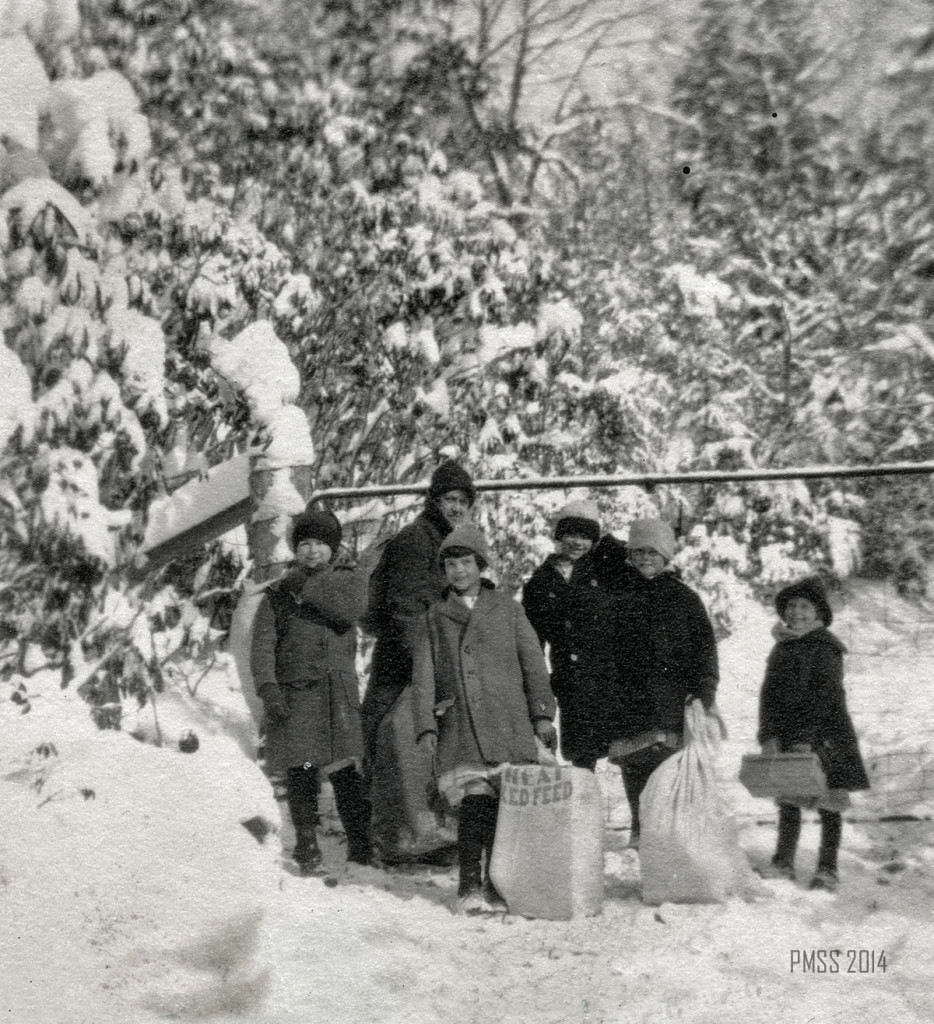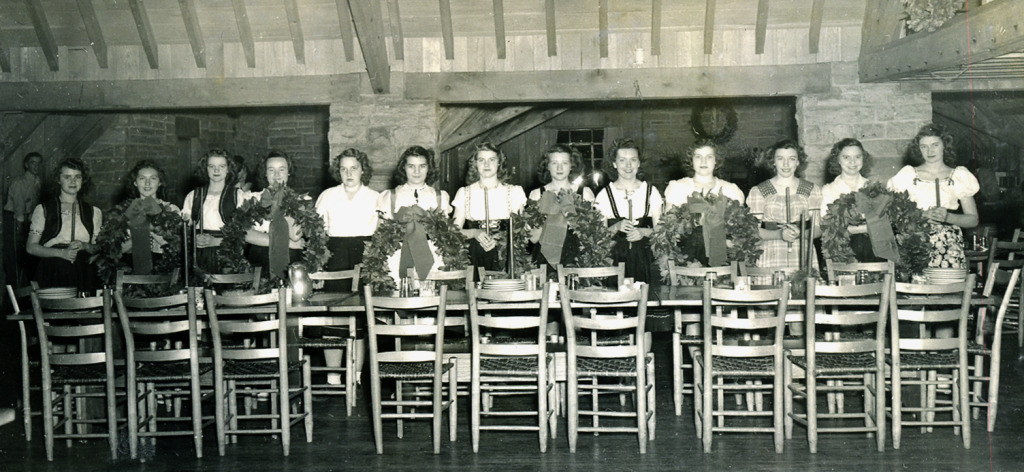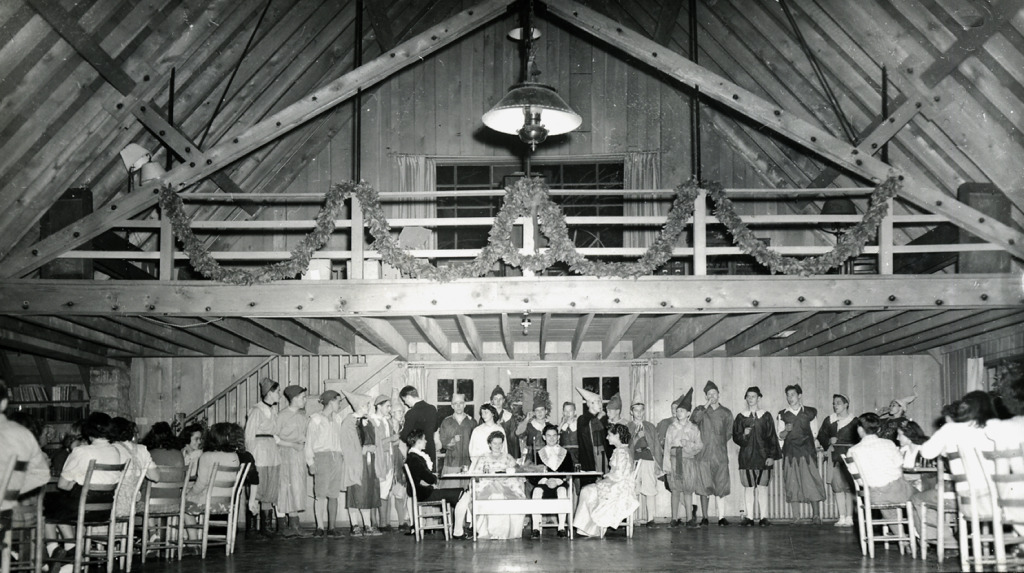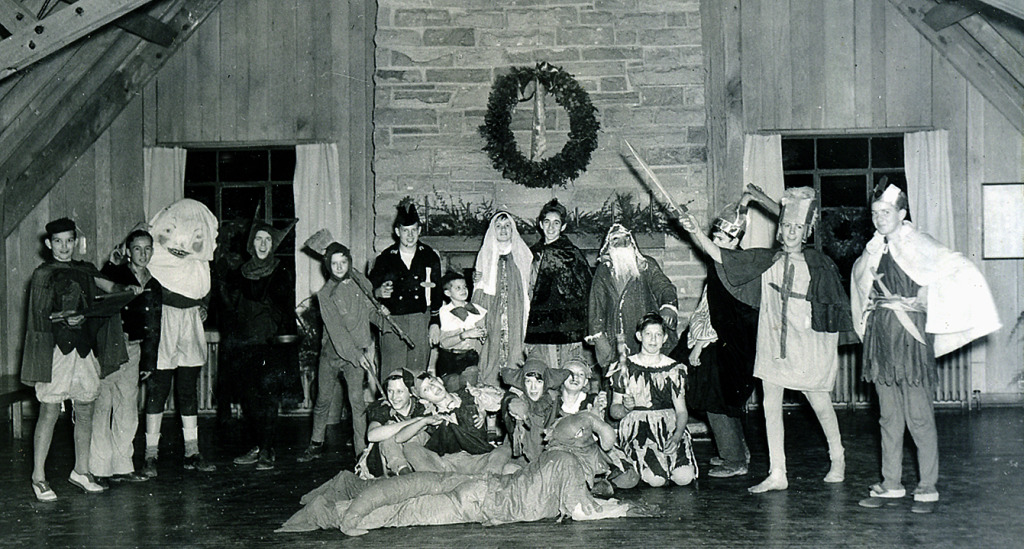Pine Mountain Settlement School
Series 16: EVENTS
Christmas at Pine Mountain Settlement School
GUIDE
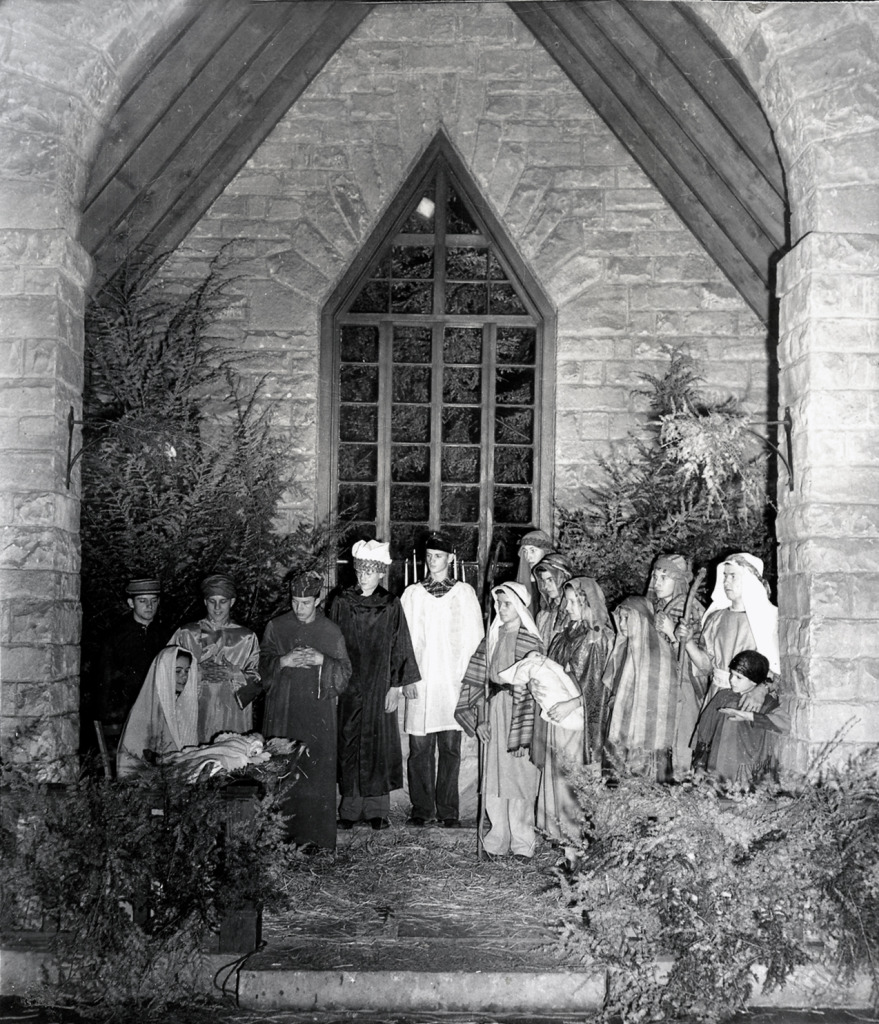
Nativity Play, 1946. Full cast: Beth LaRue, Roy Banks, Harold Cox, Arch Lewis, Bob LaRue, Jack Wilder, Ray Banks, Raymond Sturgill, Robert Calloway, Gladys Carroll, R.B. Begley [?], Bill Blackson, Densel Duncan, Frank Berry. Photograph by Arthur Dodd. [nace_1_026b.jpg]
TAGS: Christmas at Pine Mountain Settlement School Guide, Christmas at PMSS, Nativity Play, Yule Log, Margaret Motter, Mummers Play, Chapel, Katherine B. Wright, candle-lighting ceremony, caroling, ballads, August Angel, Pine Mountain Settlement School Notes 1920
Christmas at Pine Mountain Settlement School GUIDE
Christmas at Pine Mountain Settlement School is one of the most memorable times of the year. The holiday is eagerly anticipated by the whole community, particularly the presentation of the NATIVITY PLAY, a community event given in the Chapel at the School. This page will guide the user through the available resources.
Using a script written by founder Ethel de Long in the second decade of the twentieth century, costumed in mountain homespun and decorated with boughs of hemlock and pine from the nearby mountain, the solemn NATIVITY PLAY is a simple and direct telling of the birth of Christ punctuated by Christmas carols and ballads. Within the setting of the small Chapel, the event is intimate and quietly inspirational.
Once seen, few forget the Nativity Play experience, but many still remember an earlier time during the Boarding School years when the events leading up to Christmas filled most of the month of December. This guide will take readers through photographs and descriptions of early Christmas celebrations including the early NATIVITY PLAY. These celebrations are scattered throughout the records of the Archive. Many of the events were photographed or described by staff and students who shared in the holiday events. See links to some of those accounts below.
The Nativity Play has persisted. However, with the closure of the boarding school many of the other events that took place over the years during the Christmas season have largely fallen away. Echoes of those celebrations can be found in the School records cited here. For example, when the boarding school was in operation a series of sequential events during December were planned by the staff and students and were joined by many in the nearby community. Beginning with caroling and the Christmas Candle-Lighting ceremony of the girls and followed by the formal ceremony of Bringing in the Yule Log by the boys, the expectations of Christmas Day grew on campus and in the valley until the final Christmas Party and the arrival of Santa Claus. The most jubilant celebration during this period was the Mummers Play, an adaptation of ancient Celtic rituals and dance and a chance for the thespian to shine. These and other traditional events were enjoined in varying sequence through the years but, remarkably, the program varied little in its practice for most of the years that students were in residence at the School.
The accounts of Christmas celebrations were recorded by many staff, students, the Pine Cone and Conifer newsletters, and other resources such as letters, publications, and staff records. For example, a published account by Katherine B. Wright, “Glimpses of a Pine Mountain Christmas, 1921” is one of the more descriptive early accounts. Many staff narratives about their stay at the School describe the Christmas season in detail. Many narratives like to contrast the ceremonial nature of the events on campus with the more unique and informal activity in the surrounding community.
CHRISTMAS AT PINE MOUNTAIN: Earliest Years
Christmas on the north side of Pine Mountain was not always filled with the many traditional rituals adopted by the School. Before the School was established, Christmas in the valley was rarely observed in a ritualistic manner in the family homes. More often, it was a time to drink a little and shoot off guns in celebration of the season. Gifts, if given, were often simple and few. However, by the 1920s there were independent celebrations in the small schools and communities surrounding Pine Mountain Settlement School and most families had adopted the traditional rituals of the season.
In a Dear Friend Letter of 1914 a writer, probably Ethel de Long, describes the second Christmas at the School. CHRISTMAS AT PINE MOUNTAIN 1915 & 1917 describes two of the following years. Her intimate look at Christmas with the small children at the School in the opening years is fresh and touching. Her narrative captures the special importance that community members began to attach to the season following their introduction to the Pine Mountain Settlement School Christmas season. When a woman neighbor came to the second celebration of Christmas at the School wearing a few silver strands of tinsel she had saved from the first Christmas tree the year before, the importance of the new community event was clearly signaled.
During the first decade, the response to Christmas across the community was an evolution. It combined elements of imported rituals and local customs and balladry, and by the boarding school years many of the early rituals were firmly mingled and established with conventional expectations. The evolution was not difficult, from all appearances, for both the School and the larger community, the celebrations evoked and integrated the heritage of many of the people.
The “fotched-on” programs of the School were not far removed from the ancient roots and religion of many of the families in the valley. Elements of some of the ancient Christmas rituals had persisted in the minds of those who participated in the settlement school celebrations. Even today the echoes of English and Scots-Irish origins in the various celebrations resonate with many families associated with the school, Whether those echoes are from association with the School or were resurrected from family traditions, is sometimes difficult to tell. Genealogy and family heritage customs were retained down through generations in many families in the area and today the search for roots is of growing importance and interest to the families.
CHRISTMAS AT PINE MOUNTAIN: In the 1930s
Even if family lines did not thread their way back to England and Scotland, the universal appeal of the events found in many of the Christmas celebrations at the School takes it hold on memory. August Angel, Pine Mountain science and printing teacher during the 1930s and early 1940s and a son of immigrant Romanians, recorded in his memoir his first experience of the School’s Christmas celebration in 1934:
My first Christmas at Pine Mountain opened my eyes to what the holiday meant. For several weeks the entire school – students, workers, and school maintenance workers – prepared for the holiday. The buildings, especially inside, were decked in ivy and garlands of greens – fir, hemlock and pine. The scent was enlivening. The anticipation of participating in scheduled events, plus the forthcoming two-week break spent at home, produced an air of excitement.
Source: Angel, August D. “Trivia & Me.” London, KY: August David Angel, 2007: 85. Print
The main event on the campus for the Christmas season was the Nativity play and all anxiously awaited the selection of the person to play Mary, Mother of Jesus. It was the most prestigious part and vied for by all the girls on campus. Being chosen for the part of Mary entailed a combination of popularity, student vote, grade average, and teacher scrutiny – truly a meticulous way, but the right way, to pay honor to the part.
This guide to Christmas at Pine Mountain Settlement School also traces later traditions that were added or dropped from the School’s activities. By the 1940s the basic traditions were established and several new additions to the ceremonies were added by director Glyn Morris. Influenced by his Welch upbringing, Morris introduced activities that were reminiscent of “A Child’s Christmas in Wales,” the classic story by Dylan Thomas.
CHRISTMAS AT PINE MOUNTAIN: In the 1940s
During this time, another staff member and School fundraiser, Margaret Motter, gave many talks about the School to organizations, clubs and potential donors to Pine Mountain. In one of her talks, Margaret Motter Talk, “Christmas at Pine Mountain,” [1940] she details the events during the Christmas week at the School:
Christmas in the mountains is often a noisy, intemperate time – much drinking, shooting of fireworks and guns. This situation was revealed by an answer to the question put to a neighbor [about Pine Mountain Christmases] – “What kind of Christmas?” She replied, “Hit’s the peacefullest Christmas I ever seed.”
This is suggestive of far-reaching influence of schools like Pine Mountain which, through the years, has tried to foster the Christmas spirit.
Our preparation for Christmas began at Thanksgiving time for rehearsals of carols, decoration of houses, and above all – the work on the Nativity Play, the cultural feature of the week preceding Christmas vacation.
Nearly every day in the free hour of pupils, a group can be seen bound for the woods: Gaily going out carrying empty sacks or baskets and returning, laughing, singing – well laden with every variety of green from the woods of a [neighbor?].
Then the making of wreaths and garlands begins. Busy days follow until at last everything is in readiness for Open House – (Sunday afternoon when everyone goes calling on different houses to view various types of decoration.) It is amazing to see how much can be done with little insignificant things! A cheery welcome awaits the visit in each house with a hearth fire, candlelight, and festive fragrant surroundings.
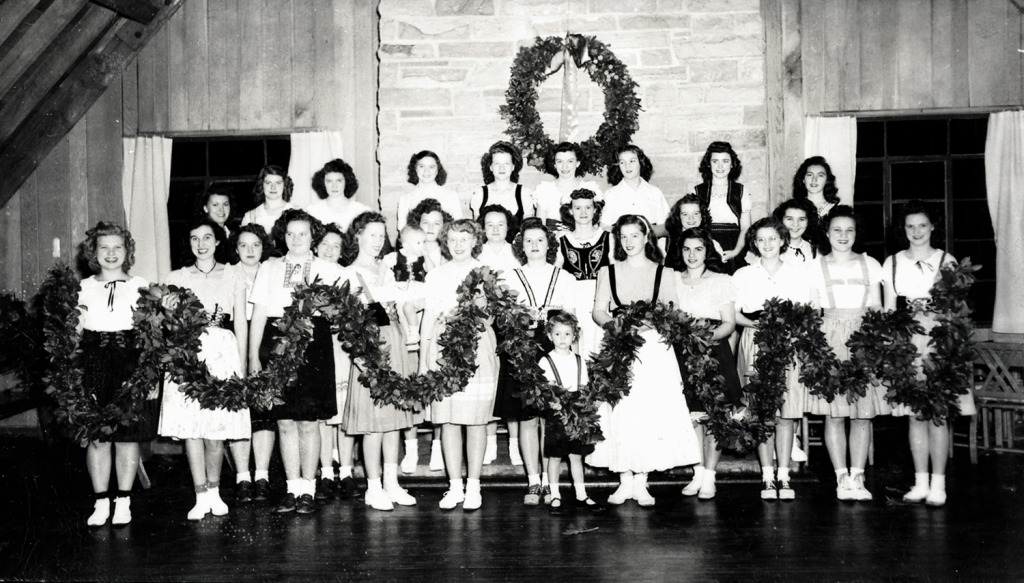
Placing “The Holly and the Ivy” in Laurel House, a PMSS Christmas ceremony. [nace_1-024b.jpg]
[page 2] The next four evenings – A special feature occurs in the dining room at supper hour after we gather there and take our accustomed places. Monday evening, we find on our table two unlighted candles. After everyone is seated, the lights are turned off and just at that moment, from the court outside, we hear voices of the least ones in school, singing “Silent Night.” During the singing of this carol the children, dressed in white, enter, carrying light tapers. They go singing to each table and light the candles till the room is “all aglow with [fr.?] light.”
After supper, a group of children dress in gay red capes with hoods and enter singing, “God Rest Ye Merry Gentlemen.” They each carry strings of woodsy things, which they’ve gathered and strung and, singing as they go from table to table, they trim the small Christmas trees. An example of trim reveals the ingenuity of the mountain child in using what he can find about him. All sorts of seed pods, sycamore balls, witch hazel, red berries, blueberries, tiny [ros.?] fungus, even popcorn – in short, anything that can be used.
Tuesday evening, after we have gathered around the table, we hear voices from the distance singing the old English carol, “The Holly and the Ivy.” About 20 girls appear on the balcony which extends around three sides of the dining room. As they reach a certain point of the carol, they lift over the railing of the balcony a garland of laurel which they have made. May I remind you that mountain people call laurel, “ivy,” as described in England years ago. This carol…[page 3]…has a special significance in the dining hall called Laurel House.
At the conclusion of supper, the girls from another house, dressed in medieval costumes, assemble on the balcony and sing, “The Twelve Days of Christmas,” which proves to be a very colorful and interesting drama when all the little wooden figures mentioned in the carol appear on the balcony rail.
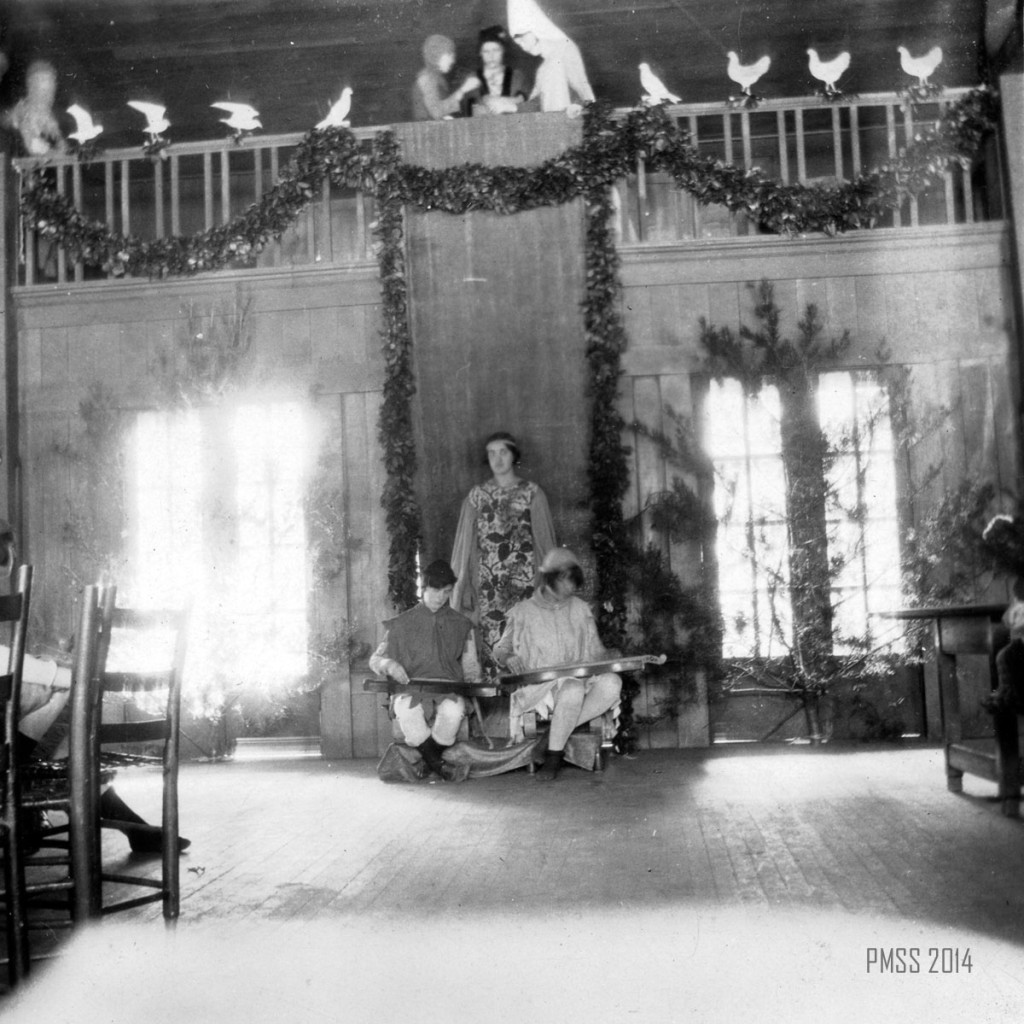
Christmas in Old Laurel House with musicians, balcony garlands and the 12 Days of Christmas play. 1921. [christmas_992.jpg]
On Wednesday at the School we have a special Christmas assembly with scripture read, carols sung, a drama of “Good King Wenceslas” and “Here We Come a-Wassailing.” The children always love this assembly.
That evening in Laurel House, we have a group of younger boys bringing in the Yule log, singing “From Far Away,” and a group of girls singing “Ye Shepherds Leave…,” bringing wreaths to place at each window. The older boys have a drama of an old carol, “There was a Song.”
On Thursday evening after supper we have a Mummers play and old Father Christmas comes bringing oranges and some simple gift for each child.
Friday evening is the climax of the week. After supper all wend our way through the quiet starry (or snowy) night to the little stone chapel where a scene of simple beauty greets us: A great towering hemlock against a gray [st.?] background and a rustic manger scene before the altar, seen in dim eerie light. It is almost breathtaking as they suggest unmistakably the setting for the Christmas story which is enacted slowly and reverently. It was my privilege to coach this play… [THE NATIVITY PLAY] [page 4]…each year and I never failed to get a catch in my throat as I heard the prophets, shepherds, and kings speak lines, and Mary sing [ex.?] the Coventry Carol – “Lullay Thou Little Tiny Child.” After the candles of [a] seven [branch] candlestick are lighted during the singing of “Adeste Fideles,” the school children and workers go quietly forward and leave at the foot of the manger some little gift which can be used when Christmas is carried into the faraway hollers and hills to children and grownups who would otherwise have no Christmas.
Thus, I think you can see that Christmas Week is a time of really getting ready for Christmas. It was an opportunity of showing mountain boys and girls (who inherit a definite culture from England) some of the beautiful customs of old England, adapted somewhat to suit their rustic environment.
It was a beautiful time, a gay time, a time of laughter and an occasional furtive tear, a time of goodly fellowship, a time for simple thoughtful giving. Can you wonder that the memory of it is deep in my heart?
Margaret Motter, “Christmas at Pine Mountain,” 1940.
CHRISTMAS AT PINE MOUNTAIN: Today’s Traditions
Today at the School the most important celebrations of the Christmas season is the community performance of the NATIVITY PLAY. The hemlock boughs have thinned out surrounding the Chapel, as the aphid hemlock woolly adelgide has taken its toll on the hemlock trees in the Southern Appalachians, and galax is nearly impossible to find or to disturb, but other greenery has been substituted for the event and has been continually used inside the Chapel. The play has seen little change from its original presentation.
CHECK THE PINE MOUNTAIN SETTLEMENT SCHOOL CALENDAR
FOR DATES AND TIMES OF THE NEXT NATIVITY PLAY.
In the last decade, in the weeks leading up to Christmas, various other small community events continue to take place arranged by Pine Mountain’s Community Outreach Coordinator, Judy Lewis, who is a native of the Pine Mountain valley.
Judy has generously given of her time and energy to provide activities for the families of the community during this special holiday season for many years. She also coaches the community children and adults in the narrative of the Nativity Play and passes along the traditions first learned under the guidance of Mary Rogers who directed the Nativity Play activities for over twenty years. The Nativity Play, which now has two performances, attracts an overflow crowd in the Chapel several weeks before Christmas Day.
See Also:
AUGUST ANGEL – “Christmas at Pine Mountain,” 1934
EVENTS CHRISTMAS AT PINE MOUNTAIN 1914, Anon. Probably by Ethel de Long.
EVENTS CHRISTMAS AT PINE MOUNTAIN 1915 & 1917
EVENTS CHRISTMAS AT PINE MOUNTAIN The Beginning
EVENTS CHRISTMAS Bringing in the Yule Log
EVENTS CHRISTMAS Candle Lighting Tradition
EVENTS CHRISTMAS Good King Wenceslas
EVENTS CHRISTMAS Holly and the Ivy
EVENTS CHRISTMAS Minuet
EVENTS CHRISTMAS Mummer’s Play
EVENTS CHRISTMAS Nativity Play
EVENTS CHRISTMAS Nativity Play Casts Through the Years
EVENTS CHRISTMAS Nativity Play Script I
EVENTS CHRISTMAS Nativity Play Script II
EVENTS CHRISTMAS Nativity Play -Mary Rogers’ Letter To Ruby Yokum
EVENTS CHRISTMAS Santa Claus, Christmas Trees, Parties Photographs
EVENTS CHRISTMAS Twelve Days of Christmas, c. 1927-28
KATHERINE B. WRIGHT Glimpses of a Pine Mountain Christmas 1921
MARGARET MOTTER TALK Christmas at Pine Mountain c. 1940
STAPLETON REPORT …1930 “THANKSGIVING & CHRISTMAS on Line Fork …”
NOTES – 1920 Description of a Pine Mountain Christmas, March 1920 issue, pages 1-2.
PMSS Song Ballads and Other Songs 1923 See “Cherry Tree Carol” ; “I Wonder as I Wander”
POSTS BY TOPIC: CELEBRATIONS See: Christmas


